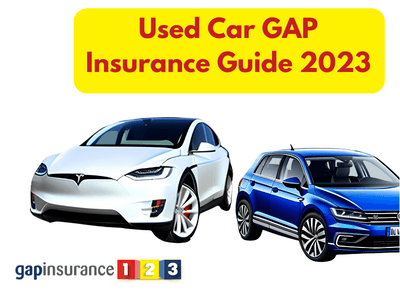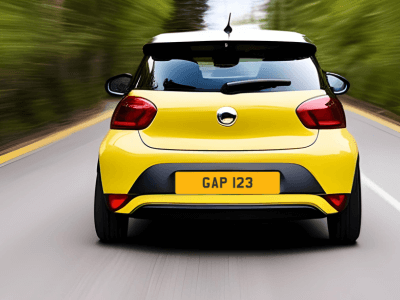Call Monday-Friday 9am - 6pm Closed Saturday & Sunday
Please select some policies.



Need Help? Calling from a mobile please call 0151 647 7556
0800 195 4926 / 0151 647 7556Do you have a question? or need help?
Call Monday-Friday 9am - 6pm Closed Saturday & Sunday,
The world of insurance can be confusing. This is especially the case when it comes to understanding Guaranteed Asset Protection (GAP) insurance.
You may be forgiven for thinking GAP Insurance is more of a 'new car' consideration. New cars are more expensive and lose value more quickly, right?
Here we will provide arguments for and against GAP Insurance on a used car. We will also explain why the choice for types of GAP Insurance cover differs from that for a brand new car.
The Ultimate Guide to Used Car GAP Insurance in the UK
The Importance of GAP Insurance
Can You Get GAP Insurance for Second-Hand Cars?
GAP Insurance Options for used cars
What Vehicles are Excluded from GAP Insurance?
Key takeaways for GAP Insurance for Used Cars
Potential Drawbacks of GAP Insurance 
Understanding the Costs of GAP Insurance
Is GAP Insurance more expensive on a used car?
Factors Influencing the Cost of GAP Insurance
GAP Insurance Providers in the UK
Choosing a GAP Insurance Provider
Comparing GAP Insurance Quotes
When to Make a GAP Insurance Claim
The GAP Insurance Claims Process.
Frequently Asked Questions about Used Car GAP Insurance
Is GAP Insurance Worth It for Used Cars?
How Long Does GAP Insurance Last?
GAP Insurance, or Guaranteed Asset Protection, is a type of insurance that covers the difference – or the 'gap' – between the amount your fully comprehensive car insurance would pay out if your car were written off or stolen and the price you paid for the vehicle (for the most common Return to Invoice GAP).
It's like a safety net, catching you when the unexpected happens.
But why is this 'gap' there in the first place? Well, it's all down to depreciation.
As soon as you drive a new car off the forecourt, its value decreases. This is more pronounced in new cars, but used cars are not immune.
If your car is stolen or written off, your car insurer will typically pay out the current market value, which could be much less than what you first paid.
This is where car GAP cover comes in, covering the difference and ensuring you're not left out of pocket.

Let's break it down with an example.
Imagine you bought a car for £15,000.
A couple of years later, your car is stolen. Your car insurer values your car at £10,000 at the time of theft.
They pay you this amount, but there's still a £5,000 'gap' between what you originally paid and what you received from your insurer.
This is where (Return to Invoice) GAP Insurance steps in, covering that £5,000 difference.
It's important to note that GAP Insurance doesn't replace your regular car insurance – it works alongside it.
You'll still need a comprehensive car insurance policy to cover repairs to your car if it's damaged in an accident.
But if your car is written off or stolen, your car insurance provider will provide the market value to you in a settlement.
GAP Insurance steps in to cover the 'gap'.
Cars depreciate. It's a fact of life. And if you're buying a used car, it's likely already experienced a fair amount of depreciation.
However, a used car will continue to lose value over time. Some will hold their value better, but some will fare far worse.
This is where GAP Insurance can provide peace of mind, knowing that you won't be left out of pocket if the worst happens. According to a 2023 update from the Motorway car depreciation guide, you can expect a 10-15% loss in value every year. Any car may be worth at least 10% less at the end of a year compared to the start of it.
But it's not just about peace of mind.
GAP Insurance can also be a financial lifesaver, particularly if you've taken out a loan to buy your car. If your vehicle is written off and you're still paying off your loan, you could owe more
to your finance company than your car insurer will pay.
GAP Insurance helps cover this shortfall so you won't be left in debt.
Yes, absolutely! GAP Insurance isn't just for shiny new cars straight out of the showroom. It's available for used cars too.
GAP Insurance could be a worthwhile consideration if you've just bought a pre-loved vehicle or had your car for a while.
But why would you need GAP Insurance for a used car?
Well, it is accepted that new cars depreciate faster than used cars. However, used vehicles still lose value over time, as discussed.
If your used car is written off or stolen, the 'gap' between what you paid for the vehicle and what your car insurer is willing to pay out is still significant.
Whether you have the car on a finance agreement (hire purchase or personal contract purchase), a personal or bank loan, or even paid for the car outright, a total loss settlement can strain your finances.
GAP Insurance covers a 'gap', ensuring you're not left out of pocket.
There are a range of types of GAP Insurance for new cars in the market. If you get a GAP Insurance quote, then you may see the following styles as the most popular for new cars:
However, the choice of used cars is a different consideration.
Vehicle Replacement GAP is aimed more at new cars. This is because the cost of a brand-new replacement vehicle could well increase over time. VRI GAP can cover these inflationary aspects that are not as acute with a used car.
Not every GAP Insurance provider allows Vehicle Replacement coverage for used cars. Many restrict VRI GAP cover just to a brand new vehicle purchase. There may be a few VRI products in the market for second-hand cars, but the advantage is unclear over RTI GAP, as it would be on a new car.
Similarly, Contract Hire and Lease GAP Insurance are designed to cover a shortfall between a car insurance payout for a total loss and the outstanding lease settlement. This lease settlement can be made up of outstanding rental payments and a difference in opinion on vehicle valuation.
Lease GAP Insurance is not an option on a used car because lease vehicles are usually brand new at the start of the lease.
Where GAP Insurance options for used cars differ
If you are looking to buy GAP Insurance for a used car, then the popular choices are:
Return to Invoice GAP Insurance
Agreed Value or Return to Value GAP Insurance
The slower depreciation seen with a used car, coupled with the cost of a like-for-like replacement, may not be any higher, meaning Return to Invoice GAP is the most popular cover style. Most car dealers will only offer RTI GAP on new and used cars. It is also the most simple style of GAP cover as you always know what the price of the vehicle is.
Most RTI GAP products are also combined products. This means they are an Invoice and Finance GAP Insurance policy rolled into one. This means they can cover a finance settlement if that is higher than the original price paid.
This means if you are concerned about settlements on finance agreements, RTI GAP can also cover this.
The second option, to be used in different circumstances, is Agreed Value GAP (also known as Return to Value GAP). This is different because it is aimed at used cars you may buy privately or from an auction, but not a car dealer.
Agreed Value GAP can cover the 'gap' between the car insurance payout and the value of your car when you take out the AVG policy. As no VAT Invoice from a motor dealer is available, the 'agreed value' is set by Glass' Guide.
Some upper limitations will come into play when buying GAP Insurance for used vehicles. Exclusions can vary between providers, but generally, they will include the following: 
Cars over a particular mileage at the GAP policy purchase date. Depending on the provider, this is capped at 80,000, 100,000 or 120,000 miles.
Cars over a certain age at the purchase of the GAP cover. This may be a maximum of 8 or 10 years old, depending on the provider.
GAP Insurance can provide financial security and peace of mind. If your car is written off or stolen, you do not have to worry about being left in a financial lurch. It can be help if you have an outstanding loan on the car.
But the benefits of GAP Insurance go beyond just covering the 'gap'. It can also provide reassurance in uncertain times. Knowing that you have GAP Insurance can provide a sense of security if you're worried about car theft or accidents.
GAP Insurance isn't for everyone. If your car is older, has high mileage, and is a lower value, the cost of GAP Insurance may outweigh the potential benefits.
The choice of GAP Insurance cover for a used car may be more restricted than for a new car.
Several factors can influence the cost of a GAP Insurance policy. However, if the car is new or used is not necessarily one of them.
If you look at a like-for-like GAP product for the same period of time and for the same purchase price of the vehicle, then the premium price should be the same. So if you buy a new car or a used car for £25,000 and take a 3-year RTI GAP policy, the premium should be the same.
Cheaper GAP Insurance products are found online rather than at motor dealers. This has been highlighted by Martin Lewis Money Saving Expert, Which? and MoneySupermarket.
But remember, the cost of GAP Insurance isn't just about the premiums. It's also about the peace of mind and the financial security it can provide. If your car is written off or stolen, the cost of GAP Insurance could be small compared to the potential economic loss you could face.
Several factors can influence the cost of GAP Insurance. These are:
vehicle purchase price - the more expensive the vehicle, the more expensive the premium
length of cover - the longer the cover, the more expensive
type of GAP Insurance - Vehicle Replacement usually is more expensive than Return to Invoice GAP
vehicle use - cover for 'standard' use is cheaper than higher risk uses like private hire taxis, driving school or chauffeur.
Choosing a GAP Insurance provider is a significant decision. Look for a provider that offers clear and straightforward policies, has a good reputation for customer service, and is financially stable. Be bold, ask questions, and ensure you understand the terms and conditions before signing on the dotted line.
When comparing providers, consider factors such as the cost of premiums, the level of coverage, and the claims process.
When comparing GAP Insurance quotes, make sure you compare like for like. Check the level of coverage, the terms and conditions, and the exclusions. Remember, the cheapest quote isn't always the best – it's about finding the right balance between cost and coverage.
For example, not all GAP policies with the same name will provide the same benefits. Vehicle Replacement products, for example, differ in benefits from provider to provider.
You should make a GAP Insurance claim as soon as your car is declared a total loss. Contact your GAP Insurance provider directly, and they will guide you through the process.
It's important to note that you'll need to provide certain information when making a claim, such as details of the incident, your standard car insurance company claim reference, car finance settlement or lease agreement settlement and car insurance payout. Ensure you have all the necessary information to help speed up the claims process.
The GAP Insurance claims process should work as follows:
Your car is involved in an accident, fire, flood, or stolen.
You inform your motor insurance provider and report to the Police (if the vehicle has been stolen).
Your motor insurer decides to write off the car as a total loss.
BEFORE you accept any offer from the motor insurer, call the claims team listed in your GAP Insurance policy cover.
Provide the required information for your GAP claim.
The GAP claims team will process your claim and make the appropriate settlement.
Full details on how to make a claim on a GAPInsurance123 policy can be found HERE.
Conclusion
GAP Insurance can provide valuable peace of mind for used car owners. Whether it's worth it depends on your circumstances, including the age and condition of your car and whether you have an outstanding loan on the vehicle. Always read the terms and conditions of any policy carefully before making a decision.
Whether GAP Insurance is worth it for used cars depends on several factors, including the age and value of the vehicle and the amount of outstanding finance. GAP Insurance is wise if the potential 'gap' is significant. 
GAP Insurance policies typically last between 1 and 5 years, but the exact duration will depend on the policy terms. Some providers offer flexible policies that allow you to choose the length of coverage that best suits your needs. You can usually cancel your GAP Insurance policy at any time, although you may receive a pro-rata refund if you cancel outside of the cooling-off period. Cancellation fees will apply.
Yes, you can cancel your GAP Insurance policy within a certain period after purchase, 14 or 30 days, depending on the provider. This is known as the cooling-off period. During this time, you can cancel your policy for any reason and receive a full refund. After the cooling-off period, you can still cancel your policy but may not receive a full refund. The the refund you will get will depend on the terms and conditions of your policy
Can I Transfer My GAP Insurance to a New Car?
Most GAP Insurance providers allow you to transfer your policy to a new car. This can be particularly useful if you decide to change vehicles during your policy term. However, you must contact your provider to discuss this, as terms and conditions vary. Some providers may charge a fee for transferring your policy, and the cost of your premiums may change based on your new car's make, model, and value.
Remember that while insurance can seem complex, it's all about protecting yourself and your investment. GAP Insurance is just one piece of the puzzle, but it's crucial for many used car owners. So take your time, research, and make the right decision. And remember, if you're ever in doubt, don't hesitate to seek advice from a professional. After all, it's always better to be safe than sorry when it comes to insurance.
Published 27/5/23, written by Mark Griffiths